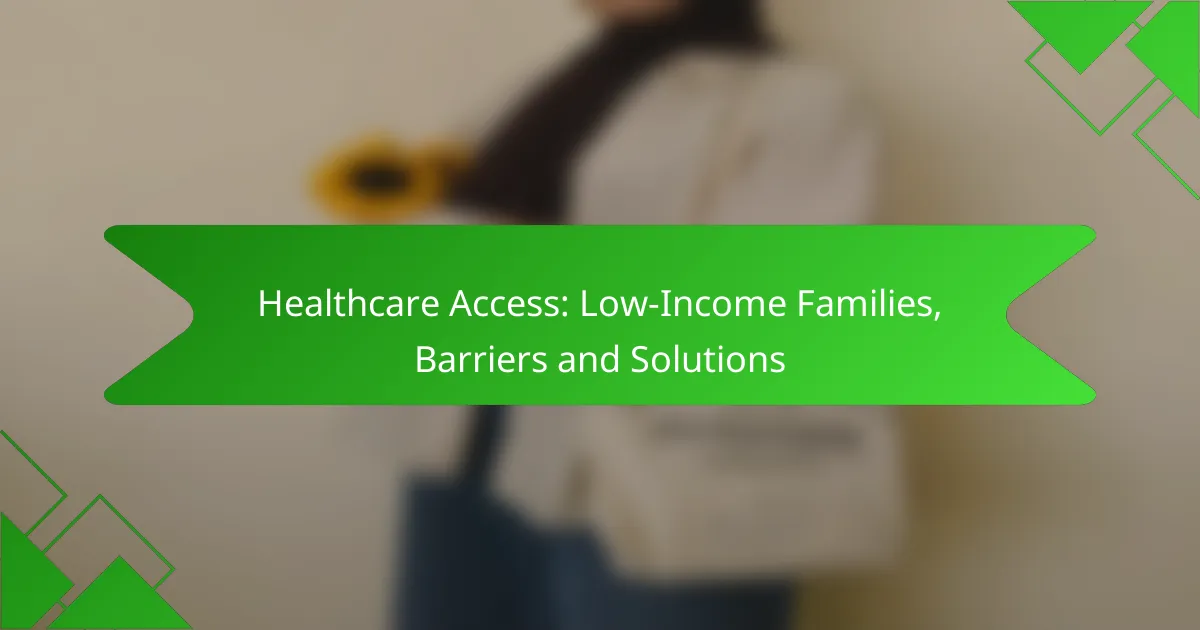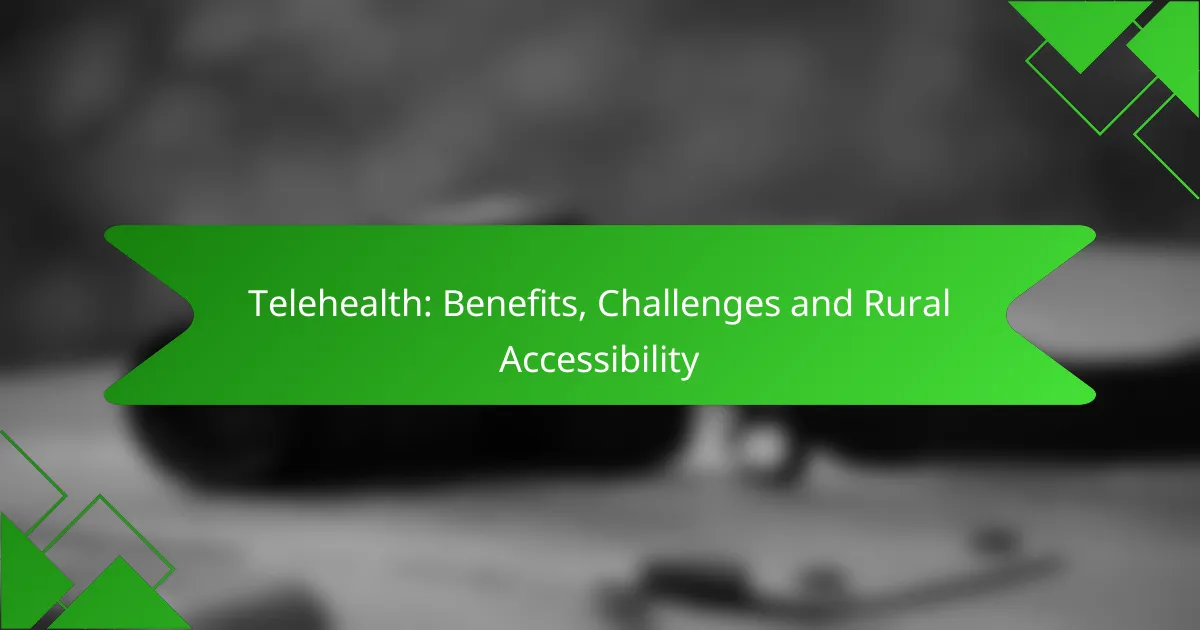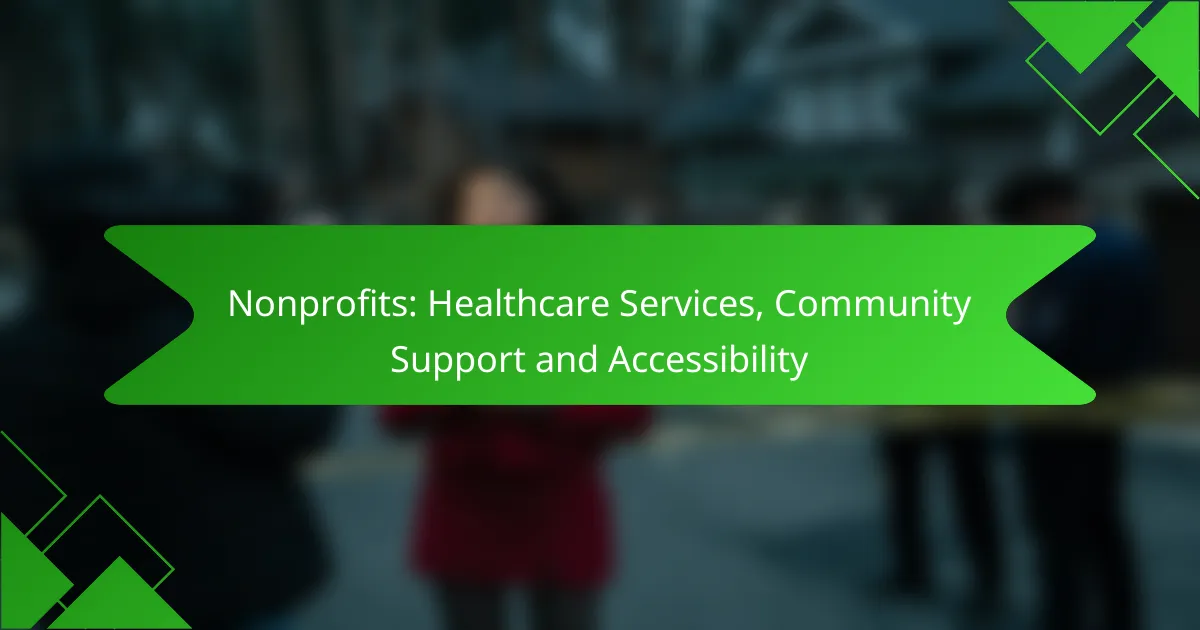Accessing healthcare can be a significant challenge for low-income families due to various barriers such as financial constraints, transportation issues, and limited insurance options. These obstacles hinder their ability to obtain timely medical care, often leading to poorer health outcomes. However, targeted solutions like community health programs and telehealth services can help bridge these gaps, providing essential support and affordable care tailored to their needs.
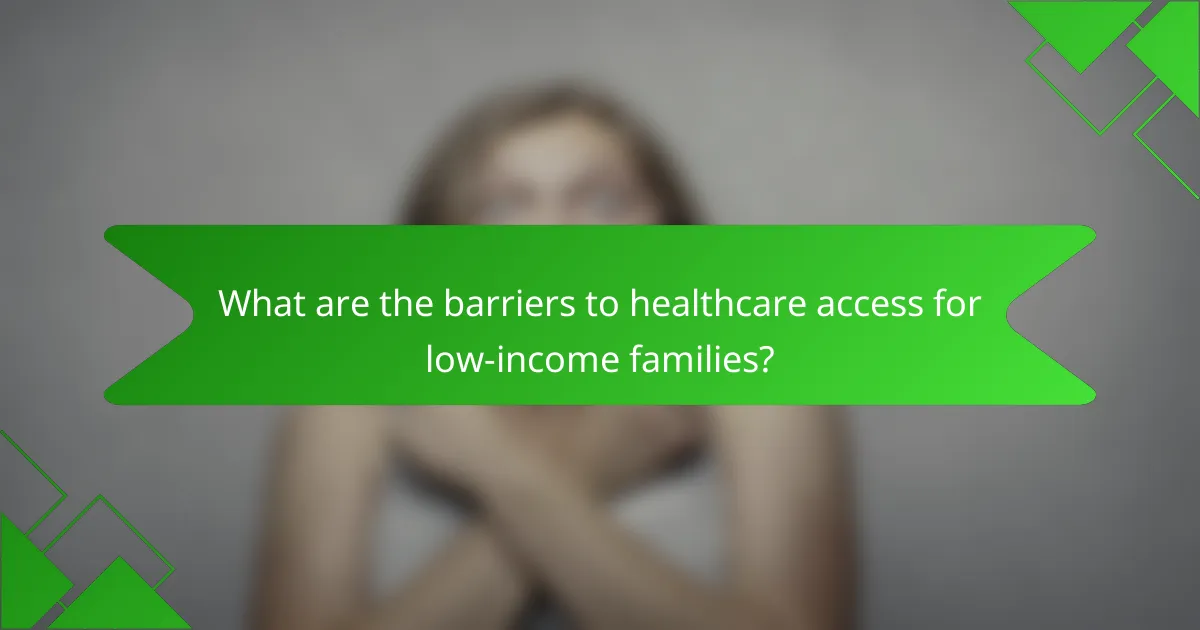
What are the barriers to healthcare access for low-income families?
Low-income families face several barriers to accessing healthcare, including financial constraints, lack of transportation, limited health insurance options, geographic location, and cultural and language barriers. These obstacles can significantly impact their ability to receive timely and adequate medical care.
Financial constraints
Financial constraints are a primary barrier for low-income families seeking healthcare. High costs associated with medical services, medications, and insurance premiums can deter families from pursuing necessary treatment. Many low-income households may prioritize basic needs like food and housing over healthcare expenses.
To mitigate these costs, families can explore community health clinics that offer sliding scale fees based on income. Additionally, government programs like Medicaid can provide essential coverage for eligible individuals, reducing out-of-pocket expenses.
Lack of transportation
A lack of reliable transportation can severely limit healthcare access for low-income families. Without a vehicle or access to public transit, attending medical appointments becomes challenging, particularly in rural areas where healthcare facilities may be far away.
Families can consider utilizing local resources such as community shuttles or rideshare programs that cater to low-income individuals. Some healthcare providers also offer transportation assistance to help patients reach their appointments.
Limited health insurance options
Limited health insurance options are a significant barrier for low-income families. Many may not qualify for employer-sponsored insurance and might find private insurance plans unaffordable. This lack of coverage can lead to delays in seeking care or avoiding it altogether.
Families should investigate state-specific programs that provide low-cost or free health insurance options, such as CHIP (Children’s Health Insurance Program) in the United States. Understanding eligibility criteria can help families secure necessary coverage.
Geographic location
Geographic location plays a crucial role in healthcare access for low-income families. Families living in rural or underserved urban areas may have limited access to healthcare facilities and specialists, leading to longer wait times and travel distances for care.
To address these challenges, families can seek telehealth services, which allow them to consult with healthcare providers remotely. This can be particularly beneficial for routine check-ups and follow-up appointments, reducing the need for travel.
Cultural and language barriers
Cultural and language barriers can hinder effective communication between healthcare providers and low-income families. Misunderstandings may arise due to differences in cultural beliefs about health or language proficiency, affecting the quality of care received.
Healthcare providers can improve access by offering translation services and cultural competency training for staff. Families should not hesitate to ask for assistance in their preferred language to ensure they fully understand their healthcare options and treatment plans.
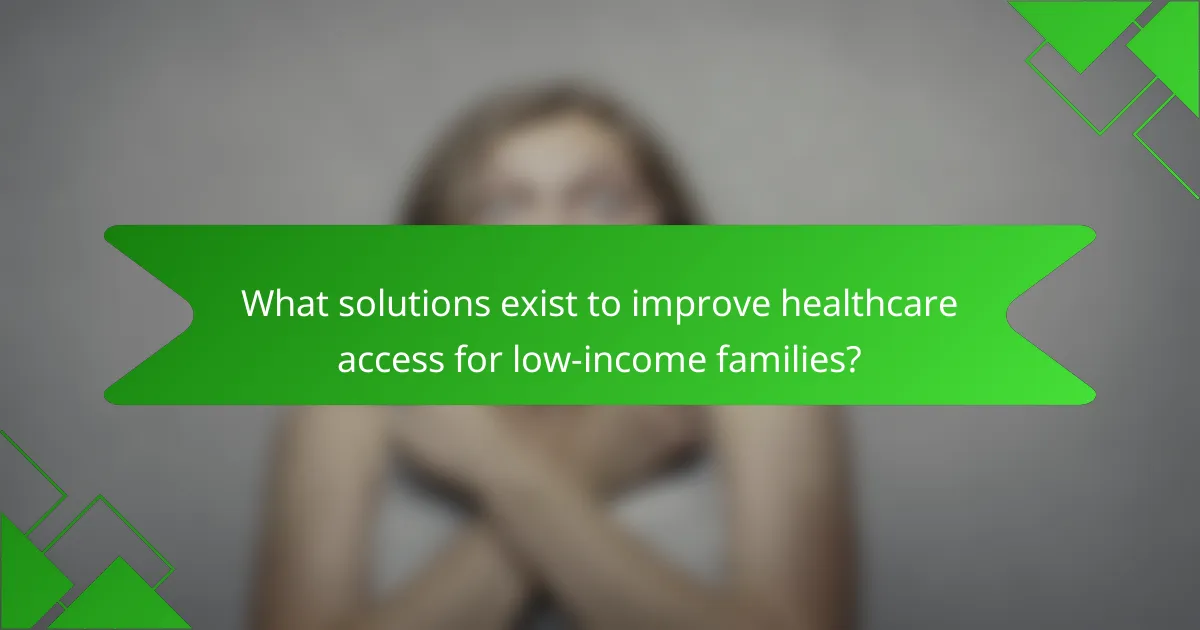
What solutions exist to improve healthcare access for low-income families?
Several effective solutions can enhance healthcare access for low-income families, including community health programs, telehealth services, sliding scale clinics, and government assistance programs. These initiatives aim to reduce barriers and provide affordable care options tailored to the needs of underserved populations.
Community health programs
Community health programs play a vital role in providing accessible healthcare services to low-income families. These programs often offer preventive care, health education, and screenings at little to no cost, helping to address health disparities in local populations.
Examples include mobile health clinics and outreach initiatives that bring services directly to neighborhoods. By partnering with local organizations, these programs can effectively reach families who may not otherwise seek care due to transportation or financial barriers.
Telehealth services
Telehealth services have emerged as a convenient option for low-income families, allowing them to access healthcare from home. These services can include virtual consultations with doctors, mental health support, and remote monitoring of chronic conditions.
Many telehealth platforms offer low-cost or free services, making them an attractive alternative for families facing financial constraints. However, it is essential to ensure that families have access to reliable internet and devices to fully benefit from these services.
Sliding scale clinics
Sliding scale clinics adjust their fees based on a patient’s income, making healthcare more affordable for low-income families. This model allows patients to pay what they can afford, ensuring that cost does not prevent them from receiving necessary medical care.
These clinics typically provide a range of services, including primary care, dental care, and mental health services. Families should inquire about sliding scale options when seeking care, as many clinics are willing to accommodate financial needs.
Government assistance programs
Government assistance programs, such as Medicaid and the Children’s Health Insurance Program (CHIP), provide essential healthcare coverage for low-income families. These programs help cover medical expenses, including doctor visits, hospital stays, and preventive care.
Eligibility for these programs often depends on income and family size, so families should check their qualifications and apply as needed. Additionally, local health departments can offer guidance on navigating these programs and accessing available resources.
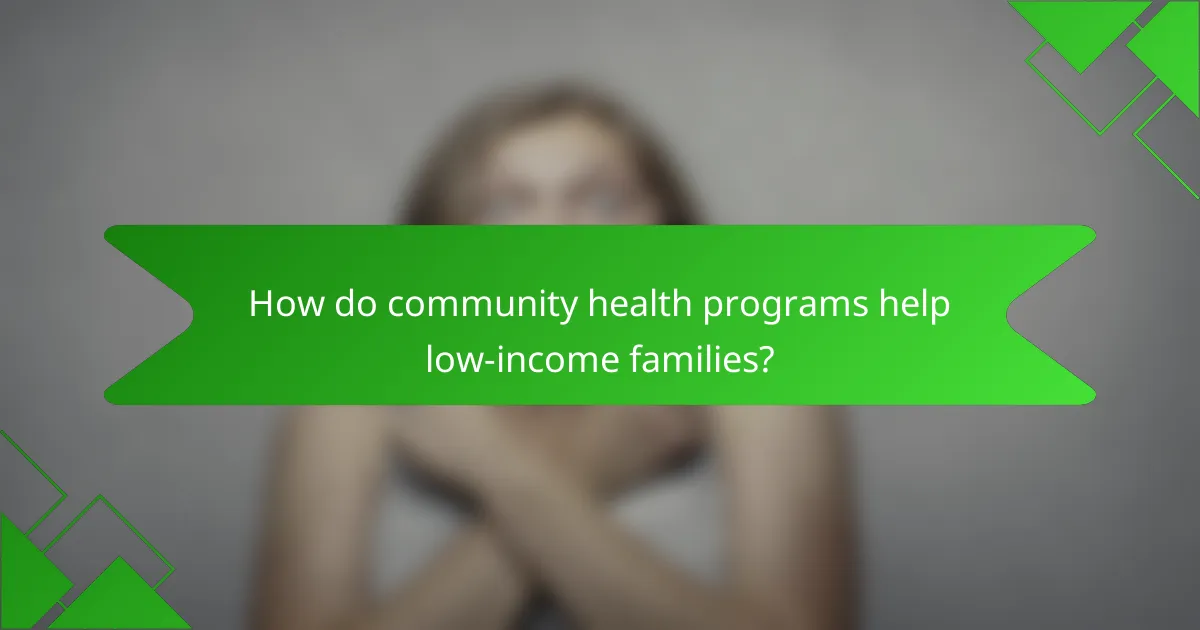
How do community health programs help low-income families?
Community health programs play a crucial role in improving healthcare access for low-income families by providing essential services tailored to their needs. These programs often address barriers such as cost, transportation, and lack of information, ensuring families receive necessary care and support.
Preventive care services
Preventive care services are vital for low-income families as they help identify health issues before they become severe. Community health programs often offer free or low-cost screenings, vaccinations, and regular check-ups, which can significantly reduce long-term healthcare costs.
For example, many clinics provide immunizations for children at no charge, ensuring they meet school requirements while protecting their health. Regular screenings for conditions like diabetes and hypertension can catch problems early, leading to better outcomes and less expensive treatments.
Health education initiatives
Health education initiatives empower low-income families by providing them with knowledge about healthy practices and available resources. These programs often include workshops, informational sessions, and materials that cover nutrition, exercise, and disease prevention.
For instance, a community health program might offer cooking classes that focus on preparing healthy meals on a budget. By equipping families with practical skills and information, these initiatives help them make informed decisions about their health and well-being.
Access to mental health resources
Access to mental health resources is essential for low-income families, as they often face higher levels of stress and mental health challenges. Community health programs frequently provide counseling services, support groups, and crisis intervention at little to no cost.
For example, many programs offer telehealth options, allowing families to connect with mental health professionals from home, which can be particularly beneficial for those with transportation issues. Additionally, raising awareness about mental health can reduce stigma and encourage families to seek help when needed.
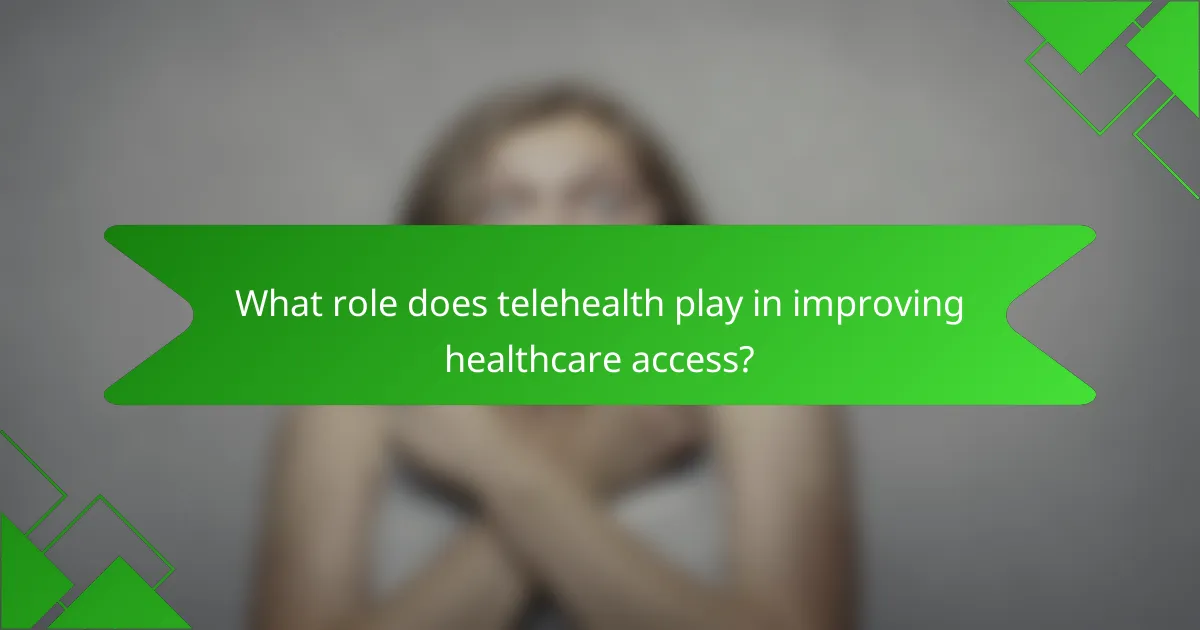
What role does telehealth play in improving healthcare access?
Telehealth significantly enhances healthcare access for low-income families by providing convenient and cost-effective medical consultations. It allows patients to receive care remotely, reducing barriers such as transportation and time constraints.
Remote consultations
Remote consultations enable patients to connect with healthcare providers through video calls or phone calls, making it easier for low-income families to seek medical advice without the need for travel. This is particularly beneficial for those living in rural areas or urban neighborhoods with limited healthcare facilities.
Patients can schedule appointments at their convenience, often outside of traditional office hours, which helps accommodate work and family responsibilities. This flexibility can lead to more consistent healthcare engagement and better management of chronic conditions.
Reduced travel costs
Telehealth reduces travel costs significantly by eliminating the need for transportation to a healthcare facility. Families can save on expenses related to fuel, public transportation, or parking fees, which can be a substantial burden for low-income households.
Additionally, the time saved from not having to travel can be used for other essential activities, such as work or childcare, further alleviating financial and logistical pressures on these families.
Increased appointment availability
Telehealth increases appointment availability by allowing healthcare providers to see more patients in a shorter amount of time. This is particularly important for low-income families who may face long wait times for in-person visits.
With telehealth, providers can manage their schedules more efficiently, offering same-day or next-day appointments that can accommodate urgent health needs. This responsiveness can lead to quicker diagnoses and treatment, ultimately improving health outcomes for families in need.

How can government assistance programs support low-income families?
Government assistance programs play a crucial role in supporting low-income families by providing access to essential healthcare services, financial aid, and nutritional support. These programs help alleviate the financial burden of medical expenses and improve overall health outcomes for vulnerable populations.
Medicaid expansion
Medicaid expansion allows states to extend healthcare coverage to more low-income individuals and families, significantly increasing access to medical services. Under the Affordable Care Act, states can choose to expand Medicaid eligibility, which typically includes those earning up to 138% of the federal poverty level.
For example, in states that have expanded Medicaid, individuals may qualify for coverage even if they previously did not meet the income requirements. This can lead to increased preventive care, reduced emergency room visits, and better management of chronic conditions.
Subsidized health insurance
Subsidized health insurance provides financial assistance to low-income families to help them afford health coverage through the Health Insurance Marketplace. Families can receive premium tax credits based on their income and family size, making insurance plans more affordable.
For instance, a family of four earning between $30,000 and $100,000 may qualify for significant subsidies, reducing their monthly premiums and out-of-pocket costs. It is essential for families to compare plans and understand their options during the open enrollment period to maximize their benefits.
Food and nutrition assistance
Food and nutrition assistance programs, such as the Supplemental Nutrition Assistance Program (SNAP), provide low-income families with funds to purchase nutritious food. These programs help ensure that families can maintain a healthy diet, which is vital for overall health and well-being.
Eligible families can receive benefits that vary based on household size and income, allowing them to buy food items at grocery stores and farmers’ markets. Utilizing these benefits can significantly reduce food insecurity and improve health outcomes, making it an essential resource for low-income households.
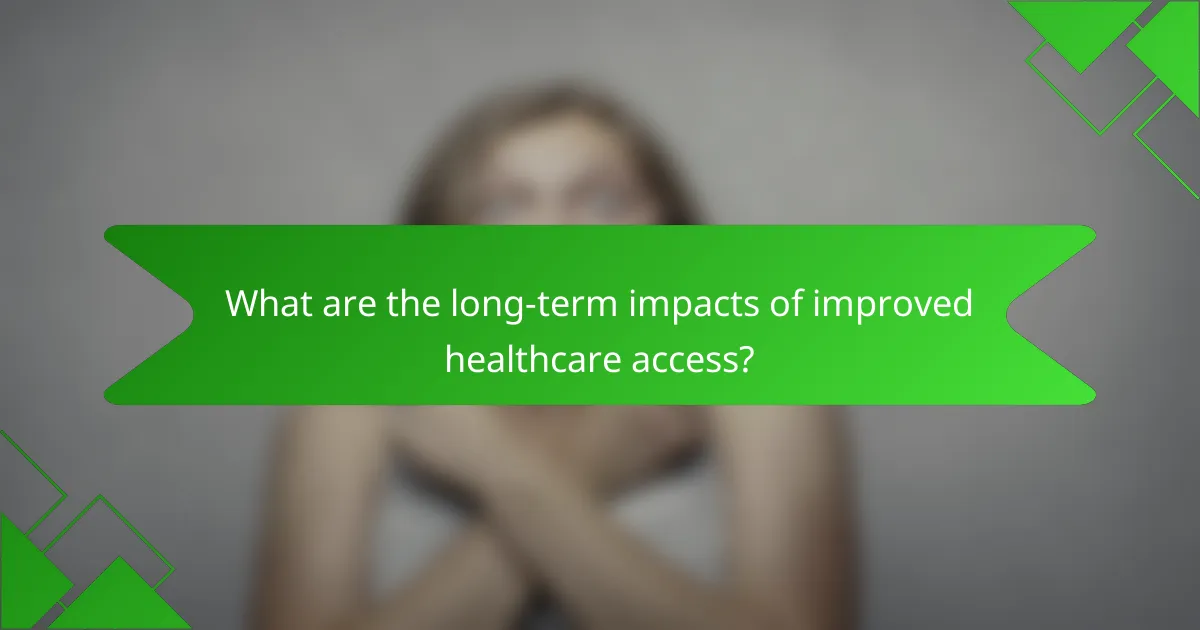
What are the long-term impacts of improved healthcare access?
Improved healthcare access can lead to significant long-term benefits for individuals and communities, including better health outcomes, increased productivity, and reduced healthcare costs. When low-income families gain access to healthcare services, they experience fewer chronic illnesses and enhanced overall well-being.
Health Outcomes
Access to healthcare services directly influences health outcomes, particularly for low-income families. Regular check-ups, preventive care, and timely treatments can lead to early detection of diseases, which significantly improves survival rates. For instance, families with consistent access to healthcare are less likely to suffer from preventable conditions such as diabetes or heart disease.
Economic Stability
Improved healthcare access contributes to economic stability for low-income families. When individuals are healthier, they are more likely to maintain employment and productivity, which can lead to higher household incomes. Additionally, reduced medical expenses from emergency care can free up financial resources for other essential needs, such as education and housing.
Community Well-being
Enhanced healthcare access fosters a healthier community overall. When families have access to necessary medical services, there is a decrease in the spread of infectious diseases and a reduction in healthcare disparities. Communities with better health profiles often see improvements in social cohesion and economic development, creating a more supportive environment for all residents.






